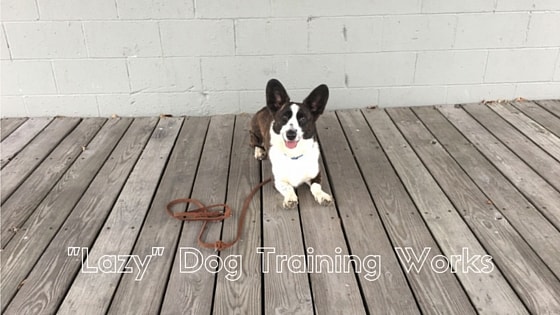Simply Put, Lazy Dog Training Works
“Lazy Dog Training” is a term I use when working with clients. Clients often feel overwhelmed by the amount of training that is truly needed. Because we are trainers and know the importance of training, it’s easy for us to show up with the energy of Richard Simmons; hitting them with a barrage of knowledge when we walk in the door. Sometimes this amount of information can overwhelm certain families making the task of training seem very daunting. For these folks lazy training can be an amazing tool for both you and your client’s toolbox since it is passive training.
Inadvertently Rewarding Other Behaviors
There are certain behaviors that can be taught and various exercises that can be done in which you are rewarding the main behavior while “secondary” and “tertiary” behaviors are also being rewarded. This is “good fallout”; a happy trickle if you will. These lazy techniques give you a 2-for or a 3-for, for the work of one.
Why not hit two birds with one stone?
One of my favorite examples of this is the Elevator Game. In this game, you are specifically teaching a dog not to jump. You begin by lowering a treat from above a sitting dog and click and treat for being able to lower the treat to the dog’s face without him jumping. Although you are rewarding the main behavior, what else is the dog learning simultaneously? The beginnings of a stay! (The staying part of the behavior would be the “secondary” behavior being learned simultaneously.) As you add a little distance and duration and, eventually, distraction, you will end up with a great little stay!
Another passive game I play is Kong-to-go-to-bed. I often start with this when doing a consult. Have the family stuff a Kong and then set up a bed or a crate a few feet away. Give the Kong to the dog and notice the dog will generally go and lay with its new stuffed Kong in bed. At first glance it might seem like that’s all that’s happening but in actuality you’ve got a magic Kong! It’s dispensing rewards for being in a down in a dog bed!
Continue the exercise by periodically walking over and exchanging the Kong for a treat. Walk away with the dog following you and then give the Kong back. The dog should return to his bed. After some repetition, cue “go to your bed” and give the Kong and watch the owner’s jaws drop as he goes to his bed on cue.
Change The Client’s Perspective
Another way I teach passive training is to change the client’s perspective by asking them to catch their dog being good. So many dog families are so quick to punish a pup when they do something wrong but rarely do they reward when the dog is doing something right. I will generally ask them to ask themselves this question, “is your dog being good or naughty this second?” If the pup is being good, feed and praise him! With a treat pouch on their hip, have them click/mark and capture moments in the day when their pup is being good. By doing this you will have a pup that is actively engaging with its owners trying to figure out “what makes them click?”
The moral of the story is to remember that just because it’s lazy training doesn’t mean the job isn’t getting done. Let’s teach owners how to train smarter, not harder.
What are some ways you will use or are using lazy training?
Get Dog Training Business Tips!
Receive valuable dog training business tips and resources every week! Subscribe to The Modern Dog Trainer now by submitting your name and email below.
[mc4wp_form]




